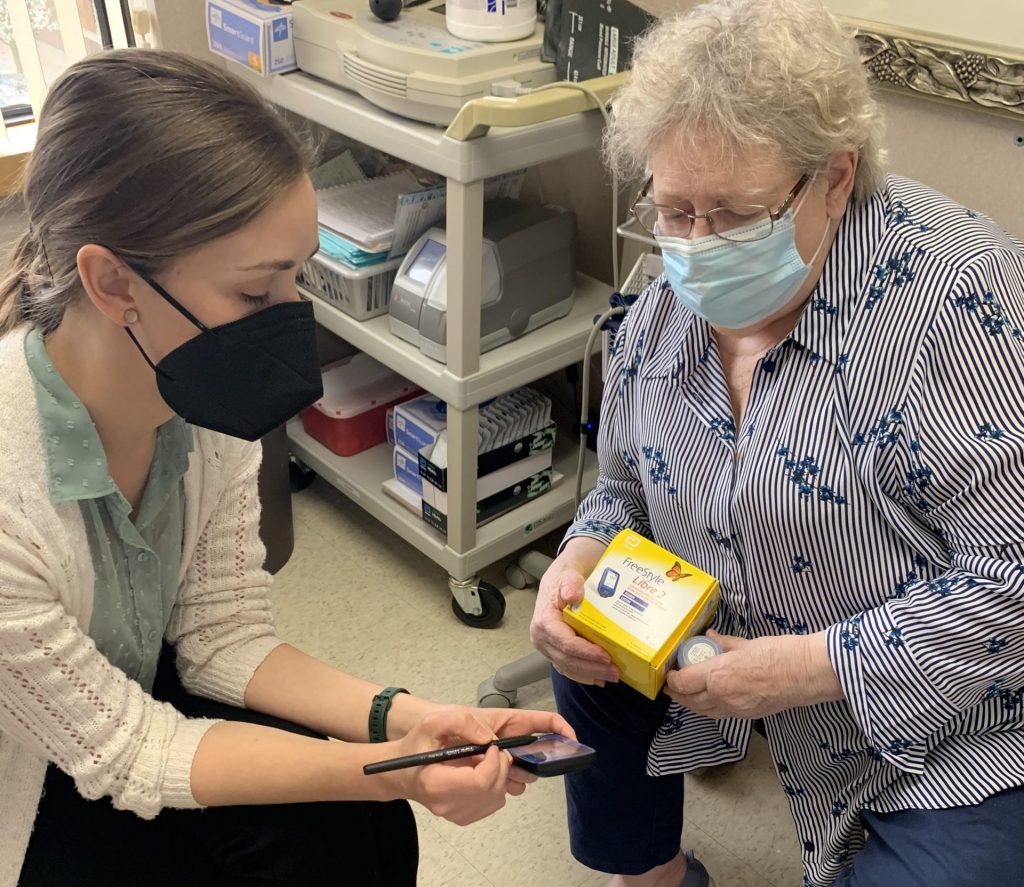Diabetes Medications
Diabetes Medications

Insulin is a hormone necessary for survival. It regulates our metabolism (of carbohydrate, protein, and fat) in countless ways. Patients with type 1 diabetes make none and, to survive, need to inject insulin every day (usually 4 times a day or through a continuous insulin infusion pump). Those with type 2 diabetes make too little insulin for their needs and secrete it usually too late to successfully cover their meal-related insulin demands. Thus, many persons with type 2 diabetes find it necessary to administer insulin, too (often alongside anti-diabetic pills or injections of other medications). Insulin cannot be ingested by mouth since the stomach juices would destroy it. In order to bypass the stomach, insulin is injected through the skin with a tiny (31 or 32-gauge, 3 to 5/16 inch long) needle. It can also be given by inhalation into the lungs just before meals (Afrezza®)
Rapid-Acting Insulins
These insulins are injected before mealtimes, usually in proportion to the carbohydrate content of the meal. They act quickly (within 15-20 minutes), reach their maximum effect in 1.5 to two hours, and last for a total of about four hours. These insulins are represented on the U.S. market by LisPro (Humalog®, Admelog®), aspart (Novolog®), and glulisine (Apidra®). The fastest-working one is Fiasp®, essentially altered Novolog®, and Lyumjev®, based on Humalog®, both allowing the more rapid onset of action.
Short-Acting Insulins
The only one used in the U.S. is Regular human insulin. It is injected 30 – 45 minutes before meals. It takes about an hour to start working, and its effect lasts about four to six (or even longer) hours. There is also a 5-times concentrated form of Regular insulin (Humulin® R U-500) which starts working at about the same time but stays active for longer (up to 12 hours).
Intermediate-Acting Insulins
These insulins take four to six hours to start working and maintain their blood-sugar-lowering effect for up to 12 to 16 hours. They are typically injected twice daily – in the morning and at bedtime. Because of their prolonged effect, their use is not tied to meals. NPH (N, cloudy) is a representative of this class.
Long-Acting Insulins
Glargine (Lantus®, Toujeo®, Semglee®, Basaglar®) and detemir (Levemir®) insulins are up to 24-hour lasting, relatively “peakless” insulins. Degludec (Tresiba®) is the longest-lasting, with effect for up to 42 hours. They are usually injected once a day. They maintain a reasonably steady effect throughout the entire day. Some patients need to inject Levemir® twice daily to cover their needs for the entire day.
Pre-mixed insulins
In some cases, physicians and their patients find it more convenient to use one of several pre-mixed insulin combinations. These are mixtures of either rapid-and intermediate-acting insulins (such as 25% Humalog & 75% NP-Humalog, 50% Humalog & 50% NP-Humalog or 30% Novolog & 70% NP-Novolog) or short- and intermediate-acting mixtures (such as 30% Regular & 70% NPH). These insulin mixes are injected before meals.
Insulin Injection Devices
Insulin can be injected either by a special syringe which the patient fills with the appropriate amount of the specific type of insulin or, preferably, by an insulin pen. The pen devices are either disposable (prefilled with 300-900 units of insulin) or permanent into which prefilled insulin cartridges are fitted.
Oral Medications Used for Treatment of Type 2 Diabetes
Drugs delaying glucose absorption from small intestine: acarbose (Precose®) and miglitol (Glyset®). These are used at mealtime to lower after-meal hyperglycemia (high sugar).
Drugs increasing insulin secretion
Short-acting: repaglinide (Prandin®) and nateglinide (Starlix®). These are used at mealtime to reduce after-meal sugar levels.
Long-acting: sulfonylureas, such as glipizide, glyburide (, and glimepiride. These medications are used once or twice daily to lower overall, but especially overnight, sugar levels. They have to be used carefully because they can lower blood glucose too much and cause hypoglycemic (low-sugar) reactions.
Drugs improving insulin action
Biguanides: metformin (Glucophage®) affects the way insulin works on the liver to decrease the amount of sugar the liver makes overnight. Metformin should not be used in patients with kidney failure.
Thiazolidinediones – (also called glitazones or TZDs) – rosiglitazone (Avandia®) and pioglitazone (Actos®) – help insulin to work especially on muscles and fat. They are long-acting, used once a day. They cannot be used when the patient has severe congestive heart failure.
Drugs preserving the “incretin” effect
DPP-4 inhibitors. These pills inhibit the action of an enzyme (DPP-4) which breaks down “incretins” (see below). This allows your own incretins work longer and enables the pancreatic islet cells to make more insulin and less glucagon when you eat. As a consequence, glucose levels are lowered.
Sitagliptin (Januvia®), saxagliptin (Onglyza®), linagliptin (Tradjenta®) and alogliptin (Nesina®) are representing this class on the U.S. market.
Drugs which lower both glucose and cholesterol
Colesevelam (Welchol®) lowers both blood sugar and “bad” (LDL) cholesterol. It works by binding bile acids but it’s not clear exactly how that lowers glucose.
Drugs with central nervous system effects
Cycloset® (bromocriptine QR) is a pill which works at the level of the brain; it improves insulin action, does not cause hypoglycemia nor weight gain and might have beneficial cardiovascular effects.
Drugs which make kidneys excrete glucose in the urine
These medications block the normal ability of the kidneys to re-absorb all the glucose from the urine back into the bloodstream (normally, we don’t have any sugar in the urine). In patients with diabetes, these pills lower blood sugar by making patients excrete it in their urine. In addition, several of these medications now have indications from the FDA to lower risks of cardiovascular vents (heart attack, stroke, death), heart failure and kidney failure. There are four such pills now approved by the FDA: canagliflozin (Invokana®), dapagliflozin (Farxiga®), empagliflozin (Jardiance®) and ertugliflozin (Steglatro®).
Drugs combining effects
These medications combine the insulin-action improving and insulin-secreting effects of the above-mentioned drugs.
- Avandamet® (combination of Avandia and metformin)
- Glucovance® (combination of glyburide and metformin)
- ACTOplus met®, ACTOplus met XR® (combination of Actos and metformin)
- Duetact® (combination of Actos and glimepiride)
- PrandiMet® (combination of Prandin and metformin)
- JanuMet® (combination of Januvia and metformin)
- Kombiglyze XR® (combination of Onglyza and metformin)
- Jentadueto® (combination of Tradjenta and metformin)
- Kazano® (combination of Nesina and metformin)
- Oseni® (combination of Nesina and pioglitazone)
- Invokamet® (combination of Invokana and metformin)
- Synjardy® (combination of Jardiance and metformin)
- Glyxambi® (combination of Jardiance and Tradjenta)
- Trijardy XR® (combination of Jardiance, Tradjenta and metformin)
- Xigduo® (combination of Farxiga and metformin)
- Qtern® (combination of Farxiga and Onglyza)
- Steglujan® (combination of Steglatro and Januvia)
- Segluromet® (combination of Steglatro and metformin)
Drugs with central nervous system effects
Cycloset® (bromocriptine QR) is a pill which works at the level of the brain; it improves insulin action, does not cause hypoglycemia nor weight gain and might have beneficial cardiovascular effects.
Drugs which make kidneys excrete glucose in the urine
These medications block the normal ability of the kidneys to re-absorb all the glucose from the urine back into the bloodstream (normally, we don’t have any sugar in the urine). In patients with diabetes, these pills lower blood sugar by making patients excrete it in their urine. In addition, several of these medications now have indications from the FDA to lower risks of cardiovascular vents (heart attack, stroke, death), heart failure and kidney failure. There are four such pills now approved by the FDA: canagliflozin (Invokana®), dapagliflozin (Farxiga®), empagliflozin (Jardiance®) and ertugliflozin (Steglatro®).
Symlin® (pramlintide) is a synthetic version of human amylin. Since amylin is normally made by the same cells as insulin, it stands to reason that patients with type 1 diabetes make none and those with type 2 diabetes make too little of it. Symlin® is, therefore, given by patients with either type 1 or type 2 diabetes (by a disposable pen device with the usual tiny needle) at mealtime, alongside their rapid-acting insulin. The possible advantages of using Symlin ® are better, smoother glucose control (while using less mealtime insulin), and weight loss.
Byetta®, Bydureon® (exenatide), Adlyxin® (lixisenatide), Victoza® (liraglutide), Trulicity® (dulaglutide), Ozempic® (semaglutide), Zepbound and Mounjaro® (tirzepatide)
Several hormones are normally released from the small intestine when we eat. They are called incretins. Byetta® was the first analog of such incretin (glucagon-like peptide 1 or GLP-1), approved by the FDA in 2005. This hormone, injected by a pen device twice daily (before breakfast and before dinner), acts at four different places: it tells the pancreatic islet beta cells to make more insulin at mealtimes; it tells the pancreatic islet alpha cells to make less glucagon (which in turn means your liver will make less sugar at mealtime); it tells the stomach to slow down its emptying (so there is less sugar spike after meals) and finally, it tells the brain that you are full, decreasing appetite and food intake. It is not insulin and its effects are quite different. In some patients, they can actually be combined with insulin.
Bydureon® is a once-weekly injectable form of exenatide, Victoza®, is injected once a day regardless of the time of the day. while Trulicity® (dulaglutide) and Ozempic® (semaglutide) are injected just once a week. There is also an oral version of semaglutide called called Rybelsus®.That tablet has to be taken in the morning on an empty stomach and has similar effects to its weekly injectable version. Mounjaro® is the first weekly injectable medication which provides effects of 2 incretins (GLP-1 and GIP). Patients using these medications can achieve better diabetes control and most experience weight loss. Initial nausea is the most common side effect (but it’s usually mild to moderate and temporary). Unlike insulin, they don’t cause hypoglycemia (low-sugar reactions). Several of the medications have FDA indications to lower cardiovascular events (heart attacks, stroke, death)
Combination of insulin and GLP-1 analogs
For patients’ convenience, these combine, in a single pen device, both long-acting insulin and GLP-1 analog. They are injected just once a day. They are marketed as Soliqua (combining insulin Lantus® and lixisenatide) and Xultophy® (combination of insulin Tresiba® and Victoza®).
Overwhelmed with options?
Your doctor will take all of your medical needs into consideration when helping you narrow down this list to include the options best suited for you. Click the button below to reserve your place on the schedule today!

